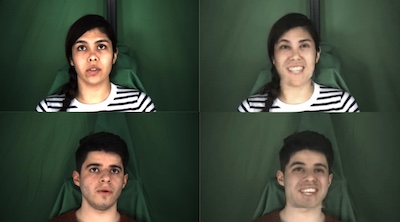ADGD @ ACM Multimedia 2021 paper
Wav2Lip-Emotion takes existing videos (real neutral inputs on left) and modifies facial expressions of emotion (generated happy outputs on right) while maintaining speakers' lip synchronization and pose. Examples here are from all-around best model on unseen faces.
We present Wav2Lip-Emotion, a video-to-video translation architecture that modifies facial expressions of emotion in videos of speakers. Previous work modifies emotion in images, uses a single image to produce a video with animated emotion, or puppets facial expressions in videos with landmarks from a reference video. However, many use cases such as modifying an actor's performance in post-production, coaching individuals to be more animated speakers, or touching up emotion in a teleconference require a video-to-video translation approach. We explore a method to maintain speakers' lip movements, identity, and pose while translating their expressed emotion. Our approach extends an existing multi-modal lip synchronization architecture to modify the speaker's emotion using L1 reconstruction and pre-trained emotion objectives. We also propose a novel automated emotion evaluation approach and corroborate it with a user study. These find that we succeed in modifying emotion while maintaining lip synchronization. Visual quality is somewhat diminished, with a trade off between greater emotion modification and visual quality between model variants. Nevertheless, we demonstrate (1) that facial expressions of emotion can be modified with nothing other than L1 reconstruction and pre-trained emotion objectives and (2) that our automated emotion evaluation approach aligns with human judgements.
git clone https://github.com/jagnusson/Wav2Lip-Emotion.git
# inside repo top directory use Dockerfile there
cd Wav2Lip-Emotion
docker build -t <image name>:<version tag> .
docker run --gpus all -dit -v /Wav2Lip-Emotion:/Wav2Lip-Emotion <image name>-<version tag> <image name>:<version tag>
docker exec -it <image name>-<version tag> bash
# install python reqs
cd Wav2Lip-Emotion
pip3 install -r requirements.txt
The Wav2Lip-Emotion model checkpoints can be found here.
Each experiment is named as mead_{source emotion}2{target emotion}_{half or full mask}_{emotion modification strategy}. The absense of an emotion strategy suffix means it uses both l1 and emotion objective. l1_only means the emotion objective is ablated and src_affect_only means the emotion modification effect of l1 is ablated by using the same emotion for inputs and targets. Logs for the trainings are also included.
Other model checkpoints to be aware of are the lipsync expert used by Wav2Lip provided by the original authors, the DenseNet121pre-trained emotion objective from Pham, Vu, and Tran (2021), and the facial landmark detector which we use for full face masking. These model checkpoints are necissary if you wish to train the model yourself as described in the next section, and should be placed in the checkpoints dir.
All data should be pre-processed to extract faces and (optionally) apply full face masking. If the data (such as MEAD) isnt already at 25 fps you should resample it to match this frame rate in the LRS2 data using scripts/resample_and_resize.sh
python3 preprocess.py --data_root <root of dataset> --preprocessed_root <output dir>
# also create full masks if you want to
bash scripts/mask_dataset.sh <dir with preprocessed data>
It is necissarry to redo the Wav2Lip original model training as we modify the masking strategy and visual quality descriminator to account for expressions of emotion in the full face. To do so you need to obtain access to the original LRS2 dataset.
python3 wav2lip-emotion_train.py --data_root <dir with preprocessed data> --checkpoint_dir <dir to place model checkpoints> --syncnet_checkpoint_path <pre-trained sync objective weights>
Further hyperparameters such as task weights are present in hparams.py. Ensure to disable affect task weight until you are ready to train that objective (next section). The timeline for other task weights is discussed in the original Wav2Lip repo.
First make sure that you pre-processed the MEAD data as described in the previous section. Now using that data and the pre-trained Wav2Lip components (re-trained in the last section) we can introduce the emotion objective and also pass in target video frames from a destination affect to alow the l1 reconstruction objective to modify emotion:
python3 wav2lip-emotion_train.py --data_root <dir with preprocessed source emotion data> --dest_affect_root <dir with preprocessed destination emotion data> --checkpoint_dir <dir to place model checkpoints> --syncnet_checkpoint_path <pre-trained sync objective weights> --checkpoint_path <generator weights> --disc_checkpoint_path <visual quality descriminator weights> --affect_checkpoint_path <affect objective weights>
Further hyperparameters such as task weights are present in hparams.py. Ensure that the affect task weight and the gt_dest_affect and mask_dest_affect are set for use of destination affects. Furthermore the desired affect is set by desired_affect.
For details on evaluation see the readme in side the evaluation directory.
This repository can only be used for personal/research/non-commercial purposes. It is derived from Wav2Lip which imposes the same restrictions. Please cite following papers for Wav2Lip-Emotion and Wav2Lip if you use this repository:
@inproceedings{10.1145/3476099.3484317,
author = {Magnusson, Ian and Sankaranarayanan, Aruna and Lippman, Andrew},
title = {Invertable Frowns: Video-to-Video Facial Emotion Translation},
year = {2021},
isbn = {9781450386821},
publisher = {Association for Computing Machinery},
address = {New York, NY, USA},
url = {https://doi.org/10.1145/3476099.3484317},
doi = {10.1145/3476099.3484317},
booktitle = {Proceedings of the 1st Workshop on Synthetic Multimedia - Audiovisual Deepfake Generation and Detection},
pages = {25–33},
numpages = {9},
keywords = {video-to-video translation, computer vision, evaluation, deep learning, emotion, facial expression, video manipulation},
location = {Virtual Event, China},
series = {ADGD '21}
}
@inproceedings{10.1145/3394171.3413532,
author = {Prajwal, K R and Mukhopadhyay, Rudrabha and Namboodiri, Vinay P. and Jawahar, C.V.},
title = {A Lip Sync Expert Is All You Need for Speech to Lip Generation In the Wild},
year = {2020},
isbn = {9781450379885},
publisher = {Association for Computing Machinery},
address = {New York, NY, USA},
url = {https://doi.org/10.1145/3394171.3413532},
doi = {10.1145/3394171.3413532},
booktitle = {Proceedings of the 28th ACM International Conference on Multimedia},
pages = {484–492},
numpages = {9},
keywords = {lip sync, talking face generation, video generation},
location = {Seattle, WA, USA},
series = {MM '20}
}
